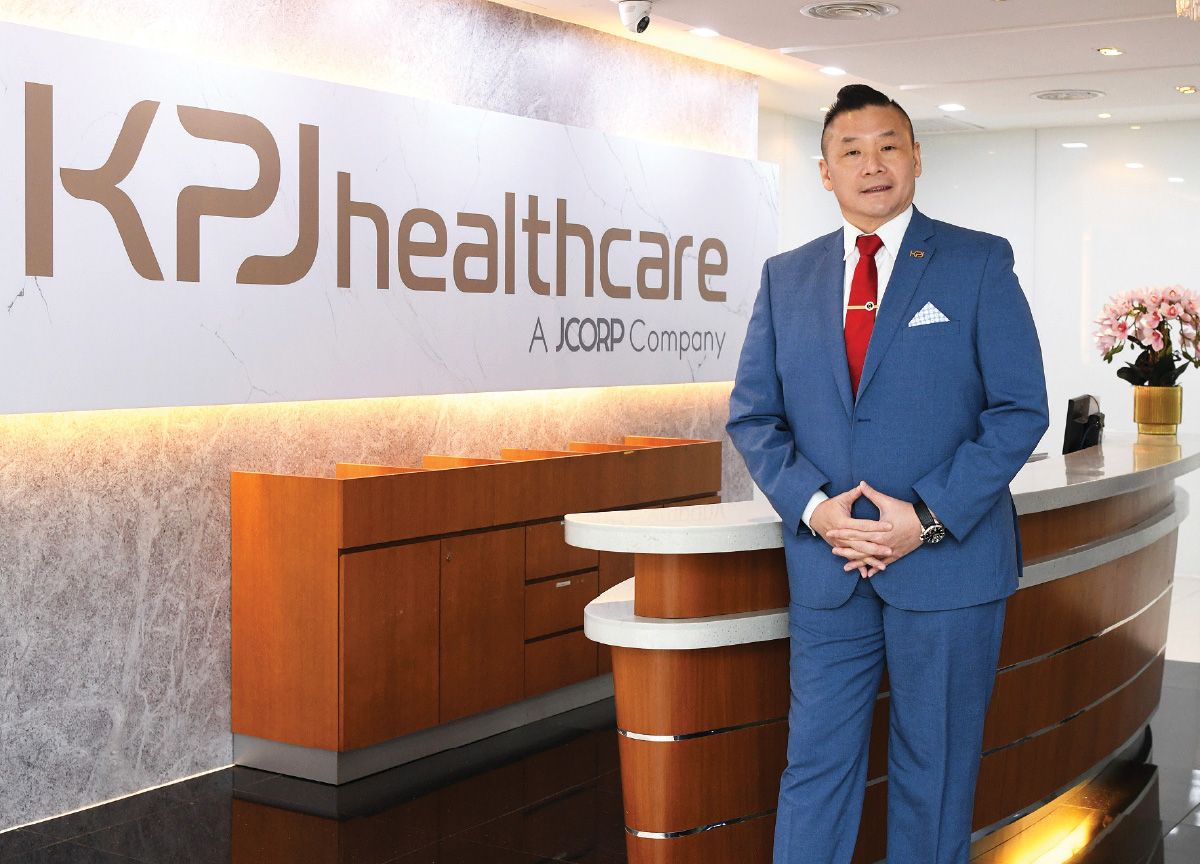
— Chin Keat Chyuan,
President and Managing Director of KPJ Healthcare Bhd
After a robust FY2024, marked by two consecutive quarters of record revenue performance and a significant surge in share price that reflects strong investor confidence, KPJ Healthcare Bhd is charting a bold new course. Under the leadership of its president and managing director Chin Keat Chyuan, the group is solidifying its position as a leading healthcare provider in Malaysia and the region through focused expansion, innovative services and a strong emphasis on patient-centric care.
The hospital operator reported a 34% year-on-year (y-o-y) jump in its FY2024 profit after tax and minority interests (Patami) to RM353.82 million, with earnings for the fourth quarter ended Dec 31, 2024, surging 64% y-o-y to RM120.52 million. Driven by increased patient visits and expanded bed capacity, annual revenue climbed about 15% y-o-y to RM3.92 billion. The group declared a special dividend per share of 0.1 sen, along with an interim DPS of 1.05 sen, bringing total DPS for FY2024 to 4.15 sen, up from 3.35 sen in FY2023.
The group’s share price, which reached an all-time high of RM2.82 in early March, remained strong at RM2.60 apiece at the time of writing. This was fuelled by expectations of sustained fundamentals in the Malaysian healthcare market, continued growth amid robust capacity expansion and higher patient volumes, with analysts revising their earnings estimates for the group upwards.
“We had a very good year. Our profit jumped and our earnings before interest, taxes, depreciation and amortisation (Ebitda) improved 18% y-o-y. Our [profit] margin grew in double digits, though our average revenue growth per patient improved only 5% to 6%. That shows that a lot of our profit came from cost savings,” says Chin shortly after the release of the group’s FY2024 results.
The stellar earnings followed the group’s implementation of a comprehensive cost optimisation strategy. This strategy leveraged the group’s extensive network of 29 hospitals to achieve better economies of scale, addressing the group’s previously lower-than-market profit margins — a key objective Chin set after his appointment in September 2023. “Our profit after tax (PAT) margin from 2023 was only 7.9%, while some of our peers in the market were commanding 13% to 15%; something was seriously amiss,” says Chin.
That “something” turned out to be the group’s procurement process. “We were not bargaining aggressively with our vendors,” says Chin. Decentralised purchasing across the network also prevented the group from capitalising on its size to secure optimised pricing, a situation that Chin, as a former president of the Pharmaceutical Association of Malaysia, or “the vendor side”, knew needed rectification.
KPJ has now centralised the procurement of core items such as imaging equipment, consumables and pharmaceuticals. By consolidating purchases across individual hospitals and leveraging group-wide volume, the group gained significant bargaining power. Open tenders for group-wide procurements resulted in savings of 15% to 70%.
Coupled with strategic negotiations with vendors for essential brands to lock in prices for up to two years, the group managed to save millions, Chin says. And the cost optimisation measures are still ongoing.
“That’s the best thing. After more than 43 years [since KPJ was established in 1981], whatever we’re trying to do now is just scratching the surface. There are a lot more things that can be done and it won’t be done in just one or two years,” he says, adding that the cost optimisation will go hand in hand with asset optimisation.
Instilling brand recognition to ‘win the hearts and minds of patients’
With the money saved, the group is reinvesting in high growth areas, aiming to “win the hearts and minds” of patients by enhancing service offerings and building brand recognition. “We’re competing very closely with our peers … Without getting that brand recognition, without getting the patient to think of KPJ first [when they face a healthcare issue], there’s no way you can win,” Chin says.
Thus, KPJ undertook a comprehensive rebranding exercise, coupled with a culture change initiative, introducing the group’s “CARE” values — commitment, accountability, respect and excellence — to instil a patient-centric mindset among KPJ staff.
These efforts have translated into improved patient feedback, Chin says, with positive trends observed in Google reviews and direct feedback. This, in turn, has led to increased inpatient and outpatient numbers and a significant rise in bed occupancy rate (BOR).
“When I first joined the company, our BOR was at a lower percentage and, now, I’m very happy to share that, as at end-2024, just looking at the same beds, without continued expansion, our BOR is now 73%. With the new bed expansion, as at the end of last year, when we had 3,847 beds, we registered 69% BOR,” Chin says. “That gives me confidence to say that when we continue to build on our capacity, our occupancy rate will continue to go up because our utilisation is there and helping us support a lot of our fixed costs.
Turning flagship hospitals into centres of excellence
While KPJ is focusing on optimising its network of 30 hospitals across the country, including the recently opened KPJ Kuala Selangor, it is also looking to attract top medical talent to its hospitals, including those in second- and third-tier cities, to draw patients from both Malaysia and overseas.
“To really put patients in the centre of everything we do, I have to give them the best service. I must give them a reason to come to us for that one thing that they can get only at KPJ and no other hospitals,” Chin says.
A prime example is KPJ’s unique offering of Minimally Invasive Cardiac Surgery for the treatment of blocked blood vessels, led by renowned surgeon Professor Dr Shahrul Amry Hashim, which Chin says reduces recovery time and infection rates compared with the conventional coronary artery bypass grafting surgery. This specialised service is part of KPJ’s strategy to create distinct value propositions that set it apart from competitors.
“To further differentiate itself, KPJ is establishing five centres of excellence (COEs) at its flagship hospitals focusing on high-value, specialised healthcare services to enhance patient outcomes: heart and lung, neurology and stroke, oncology, orthopaedics and robotic surgery. These focus areas will address the growing needs of an ageing population and the prevalence of non-communicable diseases,” Chin says.
In addition to COEs, KPJ is expanding its academic health system, which includes initiatives such as collaboration with the Mayo Clinic Care Network and enhancing its KPJ Healthcare University to provide advanced medical training and research opportunities.
“What’s unique about KPJ is that we’re the only group allowed to train master’s degree medical students, apart from the government’s parallel pathway programme. We can train up to seven specialities, four surgical and three internal medicines,” says Chin.
“More importantly, we’re also focusing on research and innovation, not only on our own but also with partners of our ecosystem, like Fujifilm, Siemens and General Electric, which can work with us on some early phases of product development and innovation. So, our KPJ Health System allows our doctors not only to focus on giving clinical services but also on training doctors and nurses, as well as being involved in research.”
Developing KPJ into an academic health system will be a game changer for the group and set KPJ apart from all other healthcare providers in Malaysia.
Local strength, global patients
As KPJ focuses on optimising its existing assets, it is prioritising the development of additional bed capacity at identified hospitals over the next five years, rather than pursuing overseas expansion.
“Why not promote our services here with our current network? Why build or buy overseas when I can bring the patients here? That’s our health tourism focus,” says Chin.
This strategic shift to prioritising sustainable growth and focusing on the group’s core strength within Malaysia is a departure from KPJ’s past expansion efforts, which included ventures in Indonesia, Australia and Bangladesh. “We shouldn’t be expanding for the sake of expanding. We’ve learnt from the past and are focused on the strategic management and development of KPJ’s Malaysian portfolio,” he adds.

The strategy has proven successful, with KPJ registering 22% growth in medical tourism revenue in 2024. “We believe our growth was about twice the industry average last year. That’s our way forward. Our COEs will also focus on international patients. The longer-term goal is to establish ourselves as the best in the region. If we do this well, even doctors from competing hospitals will refer their patients to us when their own establishments do not have the required expertise to treat their patients,” he says.
Brownfield versus greenfield
To enhance its capabilities, KPJ is looking to double the number of specialists to 2,000 over the next five years, from 1,000 currently. “Yes, everyone’s fighting for the best talent and we’re going all out to get them. We have to convince them of our way forward, our network of support and our longer-term vision and goal. For doctors, it’s not just all about how much money they can earn. It’s also about the legacy they get to leave behind,” Chin says.
KPJ also aims to increase its number of beds by 2,000 from the 3,907 it will have, which includes the 60-bed Kuala Selangor hospital. This is to raise its clinician-to-bed ratio from about 1:4 now to about 1:3, closer to its peers’ 1:2 ratio. “We’re doing this via brownfield expansion, meaning we are adding these beds to our identified hospitals,” says Chin.
While greenfield expansion is not entirely off the table, the group will proceed only when it encounters compelling business cases, Chin explains. In the meantime, the group will prioritise developing its five gestation hospitals — in Miri, Sarawak; Batu Pahat and Bandar Dato’ Onn in Johor; Damansara Specialist Hospital 2, Kuala Lumpur; and Kuala Selangor hospital in Selangor.
Clearly, Chin is focused on financial discipline and efficient resource management, and balancing KPJ’s growth ambitions with the need to deliver sustainable returns to stakeholders. The focus on optimising existing assets and attracting international patients underscores KPJ’s determination to solidify its position as a leading healthcare provider in Malaysia.
- Trump's big blunder — and no, it's not tariff per se
- Gamuda, IJM, MRCB, SunCon could bid for Penang International Airport's main terminal building under Package 3 in May, estimated at RM1.2b — CIMB
- AmBank grants RM307m in financing to Chin Hin Group for infrastructure projects
- Senator Adam Schiff calls for insider trading investigation into Trump over tariff pause
- Umno wants transfer of Seri Pacific hotel land held under trusteeship of Dr M, Daim, two others
- Malaysia must brace for potential US pharmaceutical tariff, says Dzulkefly
- Trump's aggressive stance on tariffs could impact Asean nations, says Anwar
- Govt to spur domestic investment to offset global trade uncertainty, says Amir Hamzah
- EU to pause metal counter-tariffs against US for 90 days
- UK sends top defence chief to China for first time in decade


